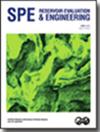油藏建模,历史匹配和表征与油藏图网络模型
IF 1.5
4区 工程技术
Q3 ENERGY & FUELS
引用次数: 0
摘要
高效的油藏模型更适合于快节奏的油藏管理。此外,由于地下流动的复杂性,捕获模型可靠性的基本物理特性也至关重要。尽管它们速度很快,但纯数据驱动的模型经常存在与可解释性、物理一致性和预测能力相关的问题。另一方面,几十年来,我们一直在使用全物理模拟模型来模拟和研究碳氢化合物系统。然而,考虑到模型的高复杂性和模型更新的不频繁,在短周期内使用全物理模型管理油藏是一个巨大的挑战。本文的目标是提出一种将油藏物理与数据驱动模型相结合的方法,以适应动态油藏管理的框架。我们建议使用基于扩散飞行时间(DTOF)概念的储层图网络(RGNet)建模方法来模拟储层行为。通过吸收现场观测数据(如压力和速率),RGNet模型可用于未来预测、情景研究和井控优化。RGNet通过离散多井三维系统的dof,将系统简化为由一组1D网格块表示的图网络,从而显著降低了系统复杂性和运行时间。RGNet还可以处理多种物理类型的流问题。在这项工作中,我们建议使用两种方法来开发可扩展到大规模系统的可靠且简约的模型。此外,我们提出了一种更稳健的方法来吸收压力数据。我们将该方法应用于一个综合和现场实例。比较了两种不同的历史匹配算法,即基于多数据同化的集成平滑算法(ES-MDA)和基于伴随的方法。虽然ES-MDA提供了不确定性分析的能力,但基于伴随的方法通常需要较少的模拟运行来生成后验模型。利用所提出的生成井间连接的方法,可以在没有系统冗余和虚假长距离井连接的情况下实现RGNet模型校准。此外,通过使用更稳定的压力匹配技术,我们发现压力数据匹配更好,储层体积更准确。RGNet提供了一种新的混合物理和数据驱动油藏建模方法,以适应闭环油藏管理(CLRM)。由于RGNet模型与基本流动物理相结合,校正后的模型参数易于解释和理解。与全物理模型相比,RGNet模型的计算成本要低得多,这使得它成为历史匹配、预测和优化实际资产的更实用的解决方案。本文章由计算机程序翻译,如有差异,请以英文原文为准。
Reservoir Modeling, History Matching, and Characterization with a Reservoir Graph Network Model
Efficient reservoir models are more desirable for fast-paced reservoir management. Moreover, due to the complexity of flow underground, it is also essential to capture the fundamental physics for model reliability. Although they are fast, pure data-driven models frequently have issues associated with interpretability, physical consistency, and ability to forecast. On the other hand, we have used full-physics simulation models to mimic and investigate hydrocarbon systems for over several decades. However, considering its infrequent model updates related to high model complexity, it is a big challenge to manage reservoirs using full-physics models in short cycles. The objective here is to propose an approach that blends reservoir physics with data-driven models to fit in the framework of dynamic reservoir management.
We propose to use a reservoir graph network (RGNet) modeling approach based on a diffusive time-of-flight (DTOF) concept to simulate reservoir behaviors. By assimilating field observation data (such as pressure and rates), an RGNet model can be used for future predictions, scenario studies, and well-control optimizations. By discretizing DTOF of a 3D system with multiple wells, RGNet simplifies the system into a graph network represented by a set of 1D grid blocks that significantly reduces the system complexity and run time. RGNet can also handle multiple flow problems with various types of physics. In this work, we propose to use two methods to develop reliable and parsimonious models scalable to large-scale systems. In addition, we propose a more robust method to assimilate pressure data.
We applied the proposed approach to a synthetic and a field example. Two different history-matching algorithms, the ensemble smoother with multiple data assimilation (ES-MDA) and an adjoint-based method, are compared. While ES-MDA provides the capability for uncertainty analysis, an adjoint-based method generally requires fewer simulation runs to generate a posterior model. With the proposed methods for generating interwell connections, RGNet model calibration can be achieved without system redundancy and spurious long-distance well connectivity. Also, by using a more stable pressure-matching technique, we show that pressure data are better matched and reservoir volume is accurately characterized.
RGNet provides a novel hybrid physics and data-driven reservoir modeling method to fit in closed-loop reservoir management (CLRM). As RGNet models are combined with fundamental flowing physics, the calibrated model parameters are easy to interpret and understand. An RGNet model runs with far less computational cost than required by a full-physics model, which allows it to be a more practical solution to history match, predict, and optimize real assets.
求助全文
通过发布文献求助,成功后即可免费获取论文全文。
去求助
来源期刊
CiteScore
5.30
自引率
0.00%
发文量
68
审稿时长
12 months
期刊介绍:
Covers the application of a wide range of topics, including reservoir characterization, geology and geophysics, core analysis, well logging, well testing, reservoir management, enhanced oil recovery, fluid mechanics, performance prediction, reservoir simulation, digital energy, uncertainty/risk assessment, information management, resource and reserve evaluation, portfolio/asset management, project valuation, and petroleum economics.

 求助内容:
求助内容: 应助结果提醒方式:
应助结果提醒方式:


